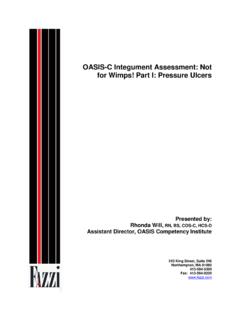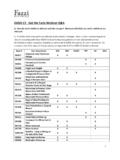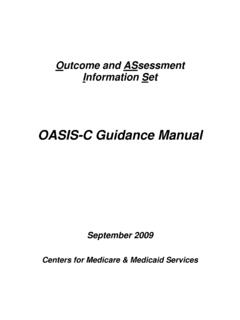Transcription of OASIS-C Integument Assessment: Not for Wimps! Part II ...
1 OASIS-C Integument Assessment: Not for Wimps! Part II: Stasis Ulcers and Surgical Wounds Presented by: Rhonda Will, RN, BS, COS-C, HCS-D Assistant Director, OASIS Competency Institute 243 King Street, Suite 246 Northampton, MA 01060 413-584-5300 Fax: 413-584-0220 5/30/20121 2012 Part II Stasis Ulcers and Surgical WoundsMay 24, 2012 Rhonda Will, RN, BS, COS C, HCS DAssistant DirectorOASIS Competency InstituteOASIS C Integument Assessment: Not for Wimps! 2012 Purpose The purpose of this activity is to enable the learner to accurately define and use wound healing principles and terminology related to stasis ulcers and surgical wounds when documenting assessment findings for stasis ulcers and surgical wounds. 2012 Objectives Define stasis ulcers and surgical wounds according to WOCN (Wound Ostomy Continence Nursing Society) Guidance on Integumentary Items and CMS OASIS C conventions. Define the healing status of stasis ulcers and surgical wounds according to WOCN Guidance on Integumentary Items and CMS OASIS C conventions.
2 5/30/20122 2012 Skin Assessment Observe the skin at every assessment time point: Temperature Color Moisture Turgor Integrity Determine wound type and etiology. Who gets credit for this wound? 2012 Wound AssessmentsA anatomic locationSsize, shape, stageS sinus tract, tunneling, fistulas, underminingE exudateSsepsisS surrounding skinM macerationE edges, epithelializationNnecrotic tissueT tissue bedS status Baranoski, S., and Ayello, 2012 OASIS Alerts! Integument items are: Based on what you see (tissue, structure, condition, etc.) Matched to the NPUAP Pressure Ulcer Stages and WOCN OASIS C Wound Guidance Document Modified by CMS guidance to report findings in OASIS data items 2012 Wound Healing Partial thickness tissue loss Involves epidermis and into but not through the dermis Superficial; presents as shallow crater, abrasion or blister Heals by epithelialization Regeneration of epidermis across a wound surface 2012 Wound Healing Full thickness tissue loss Penetrates through the fat (subcutaneous tissue) and may involve muscle, tendon, or bone Deep crater; may tunnel Heals by granulation, contraction and epithelialization5/30/20124 2012 OASIS Alert!
3 Status of the wound needs to correspond to the visual assessment of the clinician on the day of the assessment. Wound Status Not Healing Early/partial Granulation Fully Granulating Newly epithelialized Wound Guidance Document 2012 WOCN DefinitionsDegree of Healing Not healing Wound with 25% avascular tissue (eschar and/or slough) OR Signs/symptoms of infection OR Clean but non granulating wound bed OR Closed/hyperkeratotic wound edges OR Persistent failure to improve despite appropriate comprehensive wound management Early/partial granulation 25% of the wound bed is covered with granulation tissue < 25% of the wound bed is covered with avascular tissue (eschar and/or slough) No signs or symptoms of infection Wound edges open 2012 WOCN DefinitionsDegree of Healing Fully granulating Wound bed filled with granulation tissue to the level of the surrounding skin No dead space No avascular tissue (eschar and/or slough) No signs or symptoms of infection Wound edges are open Newly epithelialized Wound bed completely covered with new epithelium No exudate No avascular tissue (eschar and/or slough) No signs or symptoms of infection5/30/20125 2012M1330 Does this patient have a Stasis Ulcer?
4 Observable stasis ulcers can be visualized 2012 OASIS Alert! Stasis ulcers are: Caused by inadequate venous circulation Usually of the lower extremity May be associated with stasis dermatitis OASIS C Guidance Manual Refer to WOCN Quick Assessment of Leg Ulcers 2012 OASIS Alerts! Stasis ulcers do not include arterial lesions or arterial ulcers A healed stasis ulcer is not reported on OASIS OASIS C Guidance Manual5/30/20126 2012 OASIS Alerts! When a mixture of venous and arterial ulcers are present, report only the ones with venous disease as the etiology in M1330. An ulcer diagnosed by a physician as a diabetic ulcer is not a pressure ulcer or stasis ulcer. Q89 2012M1330 Does this patient have a Stasis Ulcer?Upon skin inspection, the clinician finds an Unna boot. The patient says it s for a stasis ulcer and the referral from the physician confirms the same. There is also an order not to remove/change the dressing for five days. The other leg also has a stasis ulcer with beefy red granulation tissue filling 75% of the wound bed.
5 2012M1332 Current Number of (Observable) Stasis UlcersUpon skin inspection, the clinician finds an Unna boot. The patient says it s for a stasis ulcer and the referral from the physician confirms the same. There is also an order not to remove/change the dressing for five days. The other leg also has a stasis ulcer with beefy red granulation tissue filling 75% of the wound 2012M1334 Status Most Problematic (Observable) Stasis UlcerDo not use! Not a response option! Most problematic is a clinical judgment 2012 OASIS Alerts! Once completely epithelialized (newly epithelialized), the stasis ulcer is considered healed. A healed stasis ulcer is not reported as a current stasis ulcer on OASIS. OASIS C Guidance Manual 2012M1340 Have a Surgical Wound? Observable surgical wounds can be visualized. Not observable , covered by a dressing or cast/device, per physician 2012 OASIS Alerts! Report current surgical wounds Unhealed wound resulting from a surgical procedure Scar Surgical wound that has been re epithelialized (epidermal resurfacing across the entire wound surface) for approximately 30 days or more without dehiscence or signs of infection How will you know when the 30 days begins?
6 2012M1340 Have a Surgical Wound?Include: Surgical site primarily closed with staples, sutures, chemical bonding agents, etc. Wound/ incision I&D or other wound with a drain placement, paracentesis, stab wound, except if an ostomy Orthopedic pin sites Muscle flap, skin advancement flap, or rotational flap to surgically replace a pressure ulcer 2012M1340 Have a Surgical Wound?Include: A take down of a previous ostomy Central line sites Medi port and port a cath sites and other sites for implanted infusion devices ( On Q pump/Q ball, etc.), venous access devices, AV shunt, and peritoneal dialysis catheter exit site regardless of functionality or frequency of accessing or not shave , punch or excisional biopsy to remove or diagnose skin lesions Implanted pacemaker site until healed and a scar5/30/20129 2012M1340 Have a Surgical Wound?Include: Incision site to implant VP shunt until healed Arthrocentesis site; surgical procedure via arthoscopy Left Ventricular Assist Device/HeartMate exit site Donor site from a skin graft to a burn or pressure ulcer Repair of a traumatic injury Excisions of a mass, abscess, mesh, other appliances or structures, etc.
7 Beyond a simple I &D Cut down in order to perform procedure per femoral sheathExclude: PICC line and Peripheral IV Pressure ulcer treated with surgical debridement or sutured closed Debridement of an existing wound (traumatic, skin graft, etc.) Old surgical wound with scar or keloid formation Ostomies even with drains ( thoracostomy/chest tube, gastrostomy, cystostomy, urostomy, tracheostomy, ileostomy, etc.) Cardiac catheterization and/or stent placement via a femoral puncture with a needle 2012M1340 Have a Surgical Wound? 2012 Exclude: Needle aspiration of fluid without drain placement Enterocutaneous fistula Simple incision and drainage of an abscess Retention suture utilizing a button Callus removal Staple sites Simple excision or removal of toenailM1340 Have a Surgical Wound?5/30/201210 2012 Exclude: Cataract surgery of the eye Surgery to the mucosal membranes Gynecological surgery via a vaginal approach Bowel ostomy or gastrostomy closing on its own Suturing of a traumatic laceration External device infusing medication via needleM1340 Have a Surgical Wound?
8 2012 OASIS Alerts! A pressure ulcer closed with a muscle flap that is not completely healed and breaks down due to pressure is a non healing surgical wound. Q 94 Implanted venous access and infusion devices remain surgical wounds as long as they are in place Q and 2012 OASIS Alerts! Presence of sutures does not automatically equate to a surgical wound. Q An I&D with a drain placement is considered a surgical wound for OASIS purposes but is not coded as aftercare as it is not considered a surgery for coding purposes. Q 2012 Surgical Wounds Frequently heal by Primary Intention Wound edges are directly next to one another Little tissue loss, no granulation occurs Wound closure is performed with sutures, staples, or adhesive May heal by Secondary Intention Has area(s) of partial or complete wound separation or dehiscence Wound is allowed to granulate 2012 OASIS Alerts! If there is any separation of the incision, then healing will be by secondary intention for data collection purposes.
9 OASIS C Guidance Manual Surgical wounds healing by primary intention do not granulate and can only be not healing until newly epithelialized for data collection. Q 2012M1342 Status of Most Problematic (Observable) Surgical WoundCovered with new epithelial tissue < 30 days5/30/201212 2012 OASIS Alerts! Presence of staples, in and of themselves, does not meet the WOCN criteria for non healing. A surgical wound with staples in place would only be considered not healing if it meets the WOCN Guidance on OASIS Skin and Wound Status MO Items definition of not healing. Q Openings in the skin, adjacent to the incision line, caused by the removal of a staple or suture are not considered part of the wound when determining the status of the surgical wound. Q 2012 OASIS Alerts! With an implanted venous access device, there may or may not be a perceptible wound with good access technique and current needle technology. Determine the healing status based on the visualization of the site.
10 Q Some sites, being held open by a needle or line cannot fully granulate and may remain non healing while the needle or line is in place. Q 2012M1342 Status of Most Problematic (Observable) Surgical WoundThe patient had a hip replacement 4 weeks ago. One week ago the therapist noted that the surgical wound completely re epithelialized without S/S of a complication. On this DC visit, the wound is described as well approximated, completely re epithelialized with no scabbing or S/S of or Secondary Intention?Newly Epithelialized or Not Healing?Not healingEarly/partial granulationFully granulatingNewly epithelializedScar/healed and not reported on OASISS tage 1 PU Stage 2 PU Stage 3 PU Stage 4 PU Closed Stage 3 or 4 PU Stasis ulcer Surgical Wound Primary Intention Surgical WoundSecondary Intention Wound Types and Possible Status of Healing for OASIS Items 2012M1350 Have a Skin Lesion or Open Wound Receiving InterventionClinical intervention: On-going clinical assessment or treatment as evidenced by orders on the POCL esion is a broad term for pathologically altered tissue; all alterations of skin integrity; see list in Q : Other wound types (burns, diabetic ulcers, cellulitis, abscesses, wounds caused by trauma, etc.)










